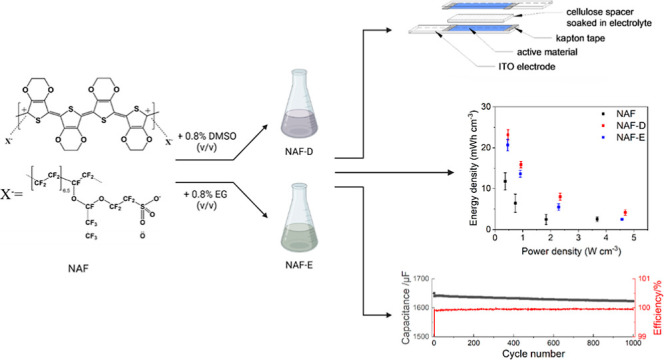- Record: found
- Abstract: found
- Article: found
PEDOT:Nafion for Highly Efficient Supercapacitors

Read this article at
Abstract

Supercapacitors offer notable properties as energy storage devices, providing high power density and fast charging and discharging while maintaining a long cycling lifetime. Although poly(3,4-ethylenedioxythiophene) doped with poly(4-styrenesulfonate) (PEDOT/PSS) has become a gold standard among organic electronics materials, researchers are still investigating ways to further improve its capacitive characteristics. In this work, we introduced Nafion as an alternative polymeric counterion to PSS to form highly capacitive PEDOT/Nafion; its advantageous supercapacitive properties were further improved by treatment with either dimethyl sulfoxide or ethylene glycol. Accordingly, electrochemical characterization of PEDOT/Nafion films revealed their high areal capacitance (22 mF cm –2 at 10 mV/s) and low charge transfer resistance (∼380 Ω), together with excellent volumetric capacitance (74 F cm –3), Coulombic efficiency (99%), and an energy density of 23.1 ± 1.5 mWh cm –3 at a power density of 0.5 W cm –3, resulting from a more effective ion diffusion inside the conductive film, as confirmed by the results of spectroscopic studies. A proof-of-concept symmetric supercapacitor based on PEDOT/Nafion was characterized with a specific capacitance of approximately 15.7 F g –1 and impressive long-term stability (Coulombic efficiency ∼99% and capacitance ∼98.7% after 1000 charging/discharging cycles), overperforming the device based on PEDOT/PSS.
Related collections
Most cited references64
- Record: found
- Abstract: found
- Article: not found
A review of electrode materials for electrochemical supercapacitors.
- Record: found
- Abstract: not found
- Article: not found